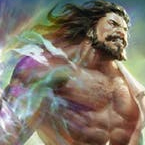Piloting a Prism deck feels similar to playing a “midrange” deck: you look to out-value your opponent through superior individual card quality. At its core, Flesh and Blood is all about gaining and holding tempo, and Prism does this by simply attacking with more power than her opponent can feasibly block on any individual turn. Prism’s hyper-efficient and overstated Heralds are hard-hitting cards with an additional upside should your opponent choose not to fully block them. The value you accrue when your Heralds hit forces your opponent to make the tough decision of either blocking fully (and settling for a severely underwhelming next turn) or letting the Herald hit. If piloting an aggressive midrange deck with many decision points and the ability to do more than half your opponent's life in one turn sounds appealing, joining the Prism cult could be right for you.
The inevitable flip side of her incredibly powerful Herald attacks is the Phantasm keyword printed on them, which states that “If this card is defended by a non-Illusionist attack with 6 or more attack, destroy this card and close the combat chain.” This inherently polarized her matchups; for the same reason she is strong against 75% of classes in the game, she is weak against the other 25%.
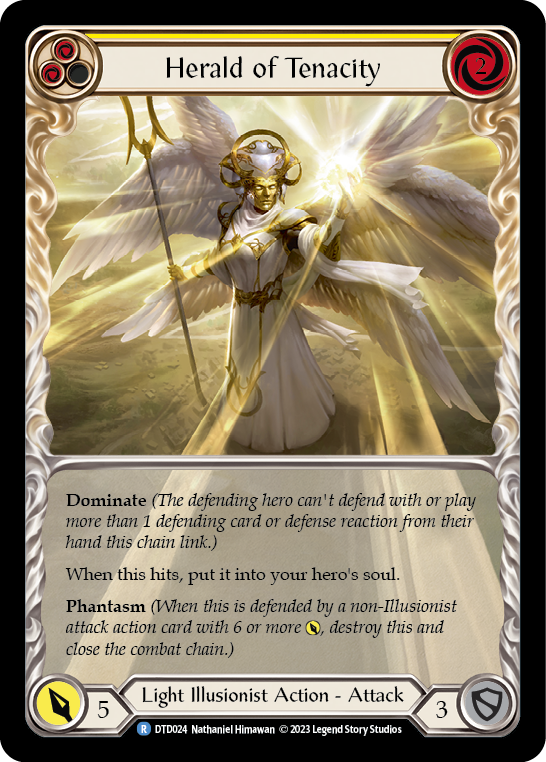
If your Phantasm attack getting popped simply meant is was blocked, that wouldn't be so bad. But because the attack does not resolve, you lose the chance to trigger “go again”. And considering Luminaris gives that effect to all your Illusionist attacks, it hurts to miss it. Your turn effectively ends as the combat chain closes. Our saving grace against surprise six attack cards is Phantasmal Footsteps, which give you the option to gain an action point the first time a card with Phantasm is destroyed on your turn.
Finding a Home in the Meta
Prism- or more specifically, Aggro Herald Prism- is a bit of a bipolar bully in these early days of Monarch's release. She excels at punishing classes that run few or no cards with six or more attack, but struggles against those that run an excess of them. Rhinar, Bravo, and Levia are all incredibly popular right now, and are the bane of a Prism deck’s existence. The Brute matchup is especially rough, as their entire deck is built around having cards with six or more attack. On the other hand, Prism’s matchups across the rest of the field range from solid to nearly inevitable.
With only one hard counter in an otherwise ideal matchup spread, Prism seems like a strong contender in the upcoming metagame.
With only one hard counter in an otherwise ideal matchup spread, she seems like a strong contender in the upcoming metagame. I believe Prism will enjoy considerable success until players adapt and start running more cards that counter Phantasm attacks, to force the Prism player to make better decisions regarding both their deck and their lines of play. And make no mistake: she will force other decks to adapt to her presence in the meta.
The Decklist

Weapons
- Luminaris (1)
Equipment
- Dream Weavers (1)
- Arcanite Skullcap (1)
- Vestige of Sol (1)
- Halo of Illumination (1)
- Phantasmal Footsteps (1)
Loadout
- Arc Light Sentinel (Yellow) (2)
- Celestial Cataclysm (Yellow) (2)
- Enlightened Strike (Red) (2)
- Enigma Chimera (Blue) (1)
- Herald of Protection (Yellow) (3)
- Herald of Judgment (Yellow) (3)
- Herald of Ravages (Blue) (3)
- Enigma Chimera (Yellow) (1)
- Herald of Triumph (Red) (3)
- Genesis (Yellow) (2)
- Herald of Ravages (Yellow) (3)
- Phantasmaclasm (Red) (3)
- Herald of Erudition (Yellow) (3)
- Herald of Rebirth (Yellow) (3)
- Herald of Tenacity (Yellow) (1)
- Herald of Triumph (Yellow) (3)
- Herald of Triumph (Blue) (3)
- Wartune Herald (Red) (3)
- Command and Conquer (Red) (3)
- Herald of Protection (Red) (3)
- Herald of Rebirth (Red) (3)
- Herald of Rebirth (Blue) (3)
- Great Library of Solana (1)
- Soul Shield (Yellow) (3)
- Pummel (Yellow) (3)
- Herald of Protection (Blue) (3)
- Wartune Herald (Yellow) (3)
- Tome of Divinity (Yellow) (2)
- Wartune Herald (Blue) (3)
Sideboard:
(note that the sideboard is included in the full deck list)
- Arcanite Skullcap
- Command and Conquer x3
- Genesis x2
- Pummel x3
- Soul Shield x3
- Great Library of Solana x1
- Arc Light Sentinel x2
Key Cards
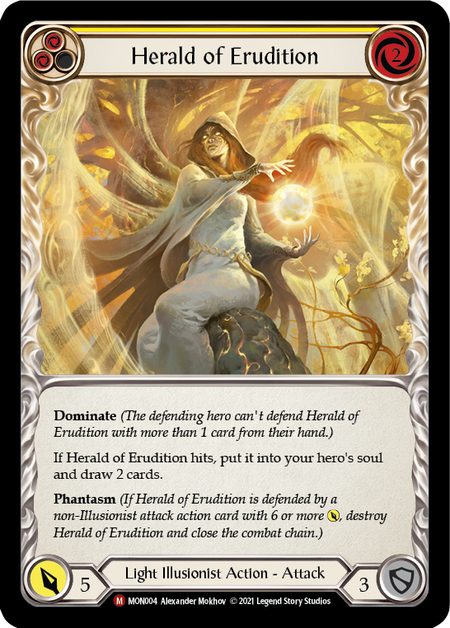
Herald of Erudition is far and away the best card in Prism’s card suite. It draws you two cards, represents a dominated threat in the late game, it pitches for yellow to turn on Luminaris. Like all the Heralds, it goes into soul on hit, activating Vestige of Sol. The card is ridiculously strong and will almost always force your opponent to supplement their block with armor. If Erudition hits and you draw into a Tome of Divinity or another Erudition, you can threaten upwards of twenty damage in a turn, making this not only a strong card, but also an incredibly strong catch-up mechanic in the deck. Erudition has my vote for one of the most powerful attack in the game, and possibly takes the top spot.
Tome of Divinity has a couple two-card combos in the deck that all net you one or more cards. Tome of Divinity plus Halo of Illumination nets you a card, puts a card in soul, and activates Vestige of Sol. This by itself would warrant the two copies in the deck- but with Herald of Erudition, Tome becomes even stronger. After hitting with Herald of Erudition, any blue pitch now fully pays for Tome, drawing you three addition cards on top of the two you drew off Erudition. If you have the luck of a god and draw into another Erudition or Tome on the same turn, you can easily one shot your opponent. While I can see the argument being made for Tome being a “win more” card, the fact it gives you the chance to come back into a game from any point is enough for me to put two copies in the deck.
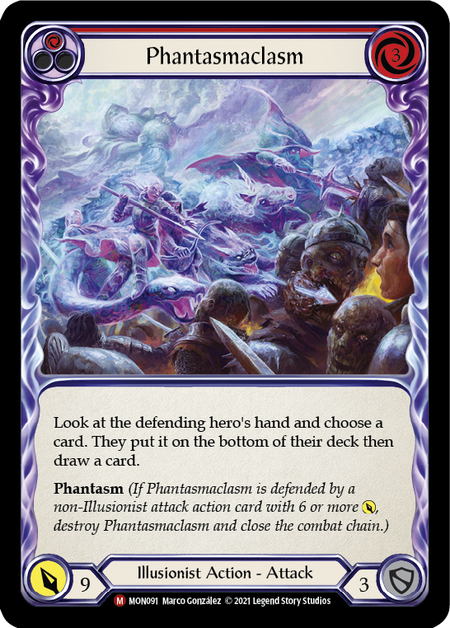
The power of Phantasmaclasm comes from ripping a card from your opponent’s hand, potentially wrecking their next turn. Taking a Sonic Boom from Wizard, a Crippling Crush from Guardian, or a Red in the Ledger from Ranger is such a powerful effect on an already strong card. The other massive benefit of Phantasmaclasm is the fact you can play it with only a blue in hand. Prism is a naturally hand hungry hero; she usually requires all four cards in her hand to threaten meaningful damage. But with Phantasmaclasm, you can block with two cards and still present nine damage to disrupt your opponent. Against your bad matchups, you can also activate your Dream Weavers to force through damage and threaten lethal.
Herald of Judgment absolutely cripples Chane decks, and potentially just outright kills them if they overextend with too many Soul Shackles. As Chane decks have a habit of running very few cards with six attack, they become forced to block with two cards from their hand, limiting the number of resources they have and thus the number of cards they can play from the Banished Zone. Herald of Judgment is a card that benefits you even if they fully block it, and paired with Pummel has the potential to essentially skip your opponent’s next turn. Outside of Shadow matchups, however, it gets benched in most games as your worst Herald.
The Question of Auras
It is my opinion that Auras (with the exception of Arc Light Sentinel and Genesis) are a trap in this style of deck. On paper, the Auras all have incredibly appealing effects that heavily influence the game and impact the way each player should make decisions. But this effect comes with some major downsides: high initial cost and no block value. In the case of the three non-majestic Auras, the effects they give you are not worth the cost because:
1. They are easily destroyed.
2. Unless you have put a card into soul, they cost 2 cards to play, and
3. They have few synergies with the rest of the cards in the deck.
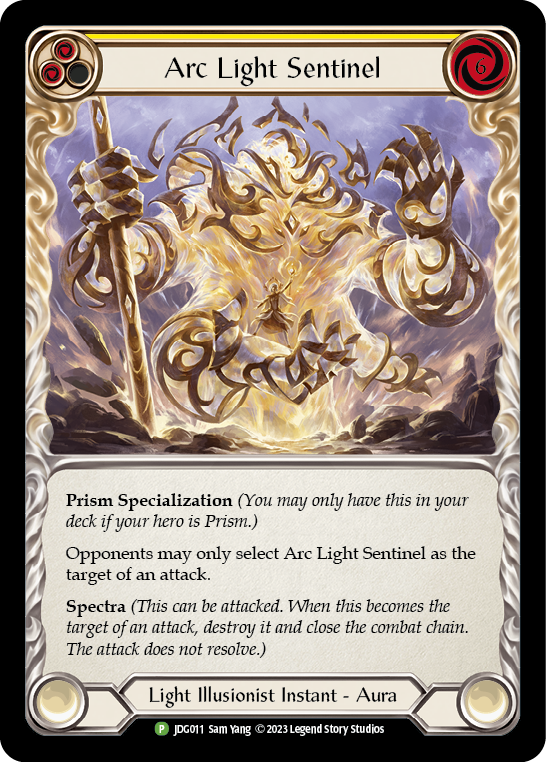
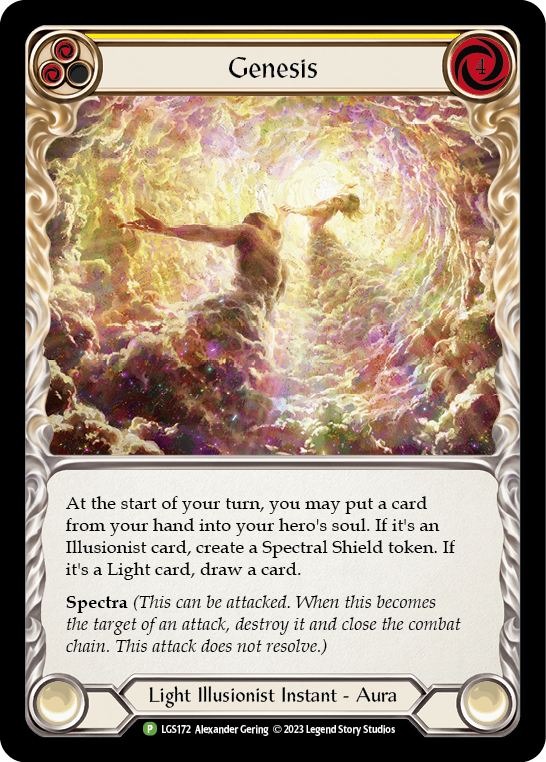
A case can be made for the merit of forcing an opponent's hand toward using their action point to destroy the Aura. The problem with this mentality is that any class comfortable with making multiple attacks in a turn can target the Aura with their final attack without much penalty, and you can't even block to keep the Aura alive. After watching many other Prism players and conducting extensive playtesting of my own, I cannot justify one more Ninja opponent ending their turn with “Kodachi for 1?” and destroying my costly Aura.
The matchups where Auras can truly reach their potential are Brute, Guardian, and Wizard, who all struggle to destroy them. For these three classes, the Auras become a huge loss of tempo, forcing them to spend their turn blowing them up. Because of this, the Auras we do run are sideboard cards.
Auras (with the exception of Arc Light Sentinel and Genesis) are a trap in this style of deck.
Theoretically, each of the Auras do something valuable: Ode to Wrath increases the damage you do, Parable of Humility decreases the damage your opponent does, and Merciful Retribution punishes them for destroying your auras.
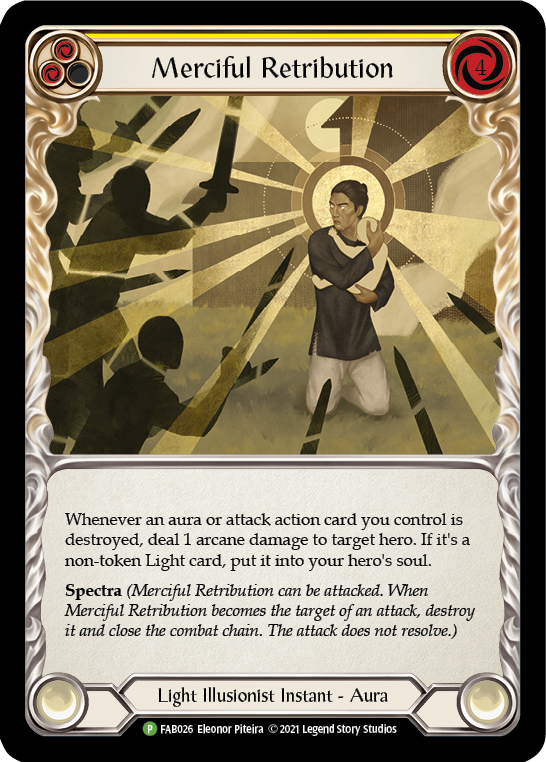
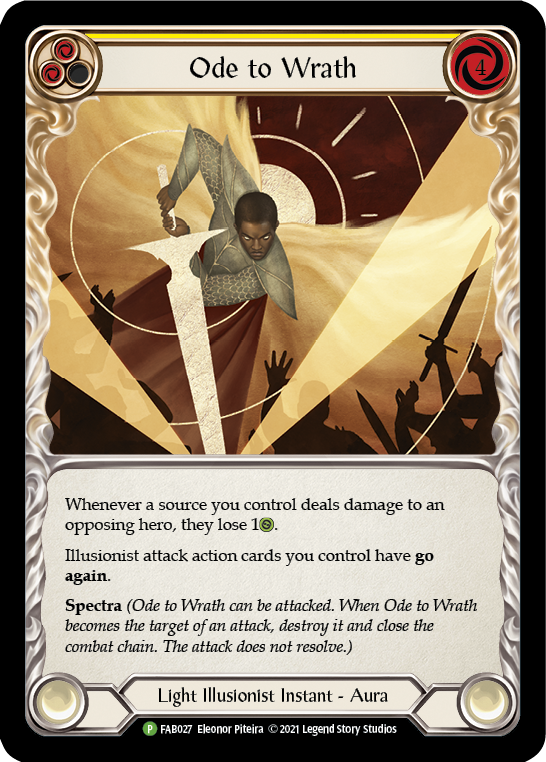
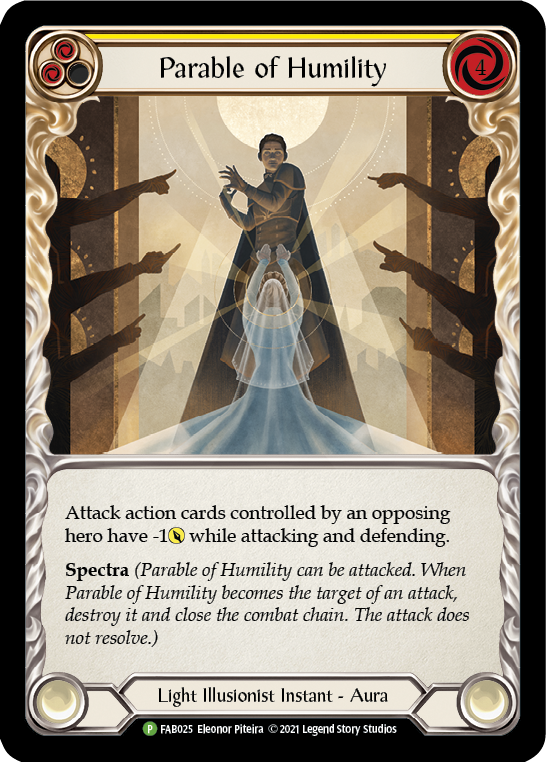
But each of these, on top of the already crippling fundamental issues with Auras, has unique shortcomings. Ode to Wrath gives your attacks go again, which they already have if you’re using Luminaris, rendering half the card obsolete. Parable of Humility only reduces damage by a modest degree, though it left unchecked, it can impair your opponent's ability to pop your phantasms. Until the card pool for Prism deepens, I can’t see a deck that relies on using Auras to control the board becoming strong in Classic Constructed.
Rules Tip: As the destruction of Auras via Spectra happens on the declaration of an attack, even an attack with 0 power will destroy the aura.
Wait, Great Library of Solana?!
I get the question, “I don’t have a Library of Solana, what can I replace it with?” often, and the short answer is, you can replace it with any Herald. The Library is not a staple card in Prism, and its impact on the deck is less substantial that fables before it, like Arknight Shard in Runeblade or Eye of Ophidia in Wizard. It is, however, an extremely effective tech piece against your two hardest match ups: Brute and Guardian.
In these difficult matchups, the Great Library of Solana allows you to attack more effectively on your turn and apply more pressure, due to having five cards in your hand. Library is at its best when you draw it early in the game, before you lose too much tempo and must start blocking with every card in your hand just to stay alive. It's important to note that Library's effect is not personal; any player that has two cards with a yellow color strip in their Pitch Zone at the end of their turn benefits from the increased Intellect. Because of this, the Library becomes detrimental against other decks that run a relatively high number of yellow cards, such as Mechanologist.
So while Library does have an incredibly strong effect, it is not necessary and doesn’t make or break a list by itself. If you start to take Prism seriously, and find yourself facing Bravo, Rhinar, and Levia frequently, you may want to seek one out for your sideboard.
The Soul of the Illusionist
The manipulation and management of the Soul mechanic in any Prism list is a key component to mastering the hero. The question: “When do I make a Spectral Shield token?” is arguably the most complicated and conditional to answer.

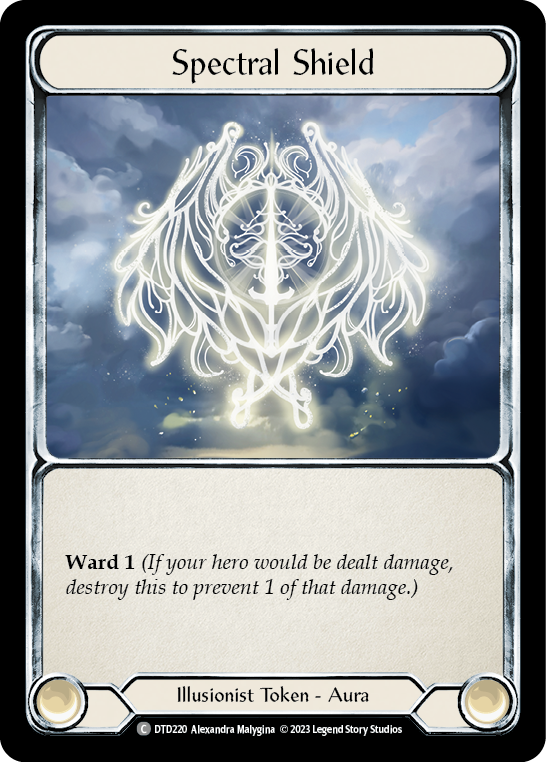
Once per turn, Prism can activate her ability when you are given priority (after your opponent plays a card or activates an effect or ability). This means that it does not use an action point and can be done in response to something your opponent does, such as playing an attack reaction. Against aggro decks, I have found that very few people ever factor in Spectral Shield creation; against cards like Ancestral Empowerment or Breaking Scales, it can represent an incredible and unexpected turn in tempo.
Against more midrange or control-based decks, you usually want to amass cards in your Soul for the use of Celestial Cataclysm, which is a massive free attack that can catch a lot of players unaware when you only have one card left in hand.
However, all of this should be taken with a grain of salt; ultimately, the game state will assert precedence. If your only way back into a game is through attacking three times in a turn, then saving cards in Soul for a Cataclysm is the best play; whereas if you’re just looking to pressure your opponent, making shield tokens at every opportunity would be the ideal play.
In the mirror match against a Control Prism, the use of Shield tokens makes the matchup almost unwinnable for the control player. This is due to the fact that the tokens swing for free after you have already swung with a full hand at your opponents' face, and can target their auras as the last attack in the turn.
Making shield tokens is a conscious decision you have to be thinking about at every point in the game.
Making shield tokens is a conscious decision you have to be thinking about at every point in the game. When deciding, you should ask yourself, “Do I see myself needing a Celestial Cataclysm to swing tempo in the next few turns?” If that answer if yes, then just keep putting cards into Soul until you reach three. If the answer if no, then decide if you want to use the ability as a defensive trick or if you want to pressure your opponent’s life total. Swinging for one over and over really starts to add up over time; just ask any Katsu player.
Mastering the use of Prism’s ability is one of the toughest things to learn as a Prism player, and becoming proficient at deciding when to activate the ability can be the difference between winning and losing a game.
In Conclusion
In many games, aggro decks are primed to take over a game at the beginning of a new meta, as they do fast, consistent damage reliably while other decks are still experimenting with new options. It's for that reason that Herald Aggro will be dominant for the first few weeks of the meta. I think Prism will find her place in the metagame quickly. Her only issue is her abysmal matchups against Guardian and Brute; but as new innovations and deck ideas surface for her, I think Prism’s matchups will only improve.
Prism is a flexible new addition to the hero roster that can be built in numerous different ways and adapted to fit any matchup she plays against. As a fast and consistent aggro deck, she will remain viable until people learn to add more six attack cards to their decks to combat her.
A continuation of "Shedding Light on Prism", Conor Grant offers matchup-specific advice on sideboarding and strategies for answering the meta.
by: Prism UwU



